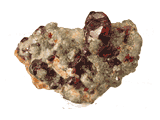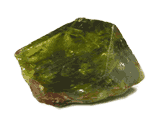| Gemstone Chart |
 Natural Brazilianite Natural Brazilianite
Brazilianite is a wonderful gemstone that is rare and hard to find. The main production area is in the Minas Gerais region of Brazil.
Color: yellow, greenish yellow
Categories: semi-precious stone
Chemical Composition: A hydrous sodium aluminum phosph
Crystal Group: Monoclinic
Refractive Index: 1.603 - 1.623
Hardness: 5.5
Density: 2.940 - 2.998
Occurrence: Minas Gerais, Brazil; New Hampshire, U.S.A.
|  Natural Clinohumite Natural Clinohumite
Clinohumite is a rare mineral and an especially rare gemstone. It is a member of the humite group of minerals, which includes humite, clinohumite, chondrodite, and norbergite.Only two sources of gem-quality material are known: the Pamir Mountains of Tajikistan, and the Taymyr region of northern Siberia.
Color: Brown, yellow, white, orange, or reddish brown
Categories: semi-precious stone
Chemical Composition: Magnesium Silicate Fluoride OH
Crystal Group: Monoclinic
Refractive Index: 1.625 – 1.668
Hardness: 6 - 6.5
Density: 3.17 - 3.35
Occurrence: Extremely rare - gem quality found only in the Pamir Mountains, Tadzhikistan. Other mineralogical occurrences include, Mt. Vesuvius, Italy; Pargas, Finland; Llanos de Juanar, Malaga, Spain; Tilly Foster Mine, New York; Fort Defiance, Apache County, Arizona; Crestmore Quarry, Riverside County and Lower Lake, Fresno County, California; Luna, New Mexico and Franklin, New Jersey, USA.
|  Natural Jadeite Natural Jadeite
A rare, usually green mineral of the pyroxene group. Jadeite can also occur in white, auburn, buff, or violet varieties. The most highly valued form of jade consists of jadeite.Jade has a history in China of at least four thousands years.Experts believe that, although more expensive, diamonds and gold cannot be compared with jade - jade is animated with a soul.
Color: Pure white thru pink, brown, red, orange, yellow, mauve, violet, blue, and black, to an extensive range of green and mottled green and white.
Categories: semi-precious stone
Chemical Composition: NaAl(SiO3)2
Crystal Group: Monoclinic
Refractive Index: 1.654 - 1.667
Hardness: 7
Density: 3.32
Occurrence: Northern Myanmar. Non commercial discoveries of Jadeite have also been reported in China; Russia (in the Polar Urals); Niigata, Japan; San Benito County, California, USA, and Guatemala.
|  Natural Kunzite Natural Kunzite
Kunzite is the pink to light purple gem variety of the mineral Spodumene.Although kunzite is a relatively soft and delicate gem, and can fade after prolonged exposure to light, its appealing color makes it a popular gem. Small gems are seldom cut from kunzite because of its cleavage and strong pleochroism. It is rarely seen in rings, necklaces, or any other forms of jewelry where small stones are required.
Color: Pink, Lilac, Light Violet
Categories: semi-precious stone
Chemical Composition: LiAlSi2O6
Crystal Group: Monoclinic
Refractive Index: 1.660 - 1.675
Hardness: 7
Density: 3.17 - 3.19
Occurrence: Africa, Brazil, Canada, Madagascar, Mexico, Myanmar, Afghanistan, Sweden, and USA (California).
|  Natural Moonstone Natural Moonstone
The most common moonstone is of the mineral adularia.It is an opaque stone, a simi-clear white, kind of the color of watered down milk.Moonstone Jewellery uses the gemstone moonstone as its main stone.
Color: white, blueish white.
Categories: semi-precious stone
Chemical Composition: KalSI3O8
Crystal Group: Monoclinic
Refractive Index: 1.518 – 1.526
Hardness: 6 – 6.50
Density: 2.55 – 2.57
Occurrence: Sri Lanka, India, Madagascar, Burma, Tanzania, U.S.A.
|  Natural Sapphirine Natural Sapphirine
Sapphirine is a rare mineral, a silicate of magnesium and aluminium.Though Sapphirine clearly falls into the "rare stone" category, it is a relatively durable stone with a Moh's hardness of 7.5. Sapphirine's very distinctive appearance along with their somewhat unusual durability have made them fairly popular with collectors.
Color: Pale blue, bluish gray, greenish gray, green, purplish pink
Categories: semi-precious stone
Crystal Group: Monoclinic
Refractive Index: 1.714-1.723
Hardness: 7.5
Density: 3.4-3.5
Occurrence: U.S.A., U.K., Sweden, Czechoslovakia, Japan, South Africa, Greenland, Madagascar, Italy, Sri Lanka
|  Natural Sphene Natural Sphene
Sphene is also known as calcium titanium silicate.It is named from the greek word for wedge, because of its typical wedge shaped crystal habit.Because of it's high dispersion and refractive index, a well cut sphene can display stunning brilliance. Sphene is somewhat soft and as a result is more suitable as a pendant than as a ring stone. Sphene is rarely very clean.
Color: Green, yellow. brown
Categories: semi-precious stone
Chemical Composition: CaTiSiO5
Crystal Group: Monoclinic
Refractive Index: (1.885-1.990,)-(1.915-2.050)
Hardness: 5.5
Density: 3.52-3.54
Occurrence: Austria, Dheirene-Madagascar, India, USA, Brazil.
|  Natural Triplite Natural Triplite
Triplite is a rare fluoro-hydroxide phosphate mineral that forms in phosphate rich granitic pegmatites and high temperature hydrothermal veins. The name is from the Greek triplos for triple, in reference to the three cleavage directions. It is a very gemstones and few cut stones have been ever reported.
Color: brightly coloured (brown, salmon, flesh-red)
Categories: semi-precious stone
Chemical Composition: (Mn,Fe2+)2(PO4)(F,OH)
Crystal Group: Monoclinic
Refractive Index: 1.650 - 1.680
Hardness: 5 - 5.5
Density: 3.44 - 3.90
Occurrence: the Shigar Valley, Pakistan; China; France, Bavaria, Germany; Kimito, Finland; Karibib, Namibia; Maine, and Connecticut, Arizona and Colorado in the United States.
|
|
